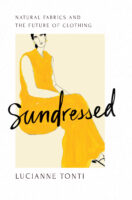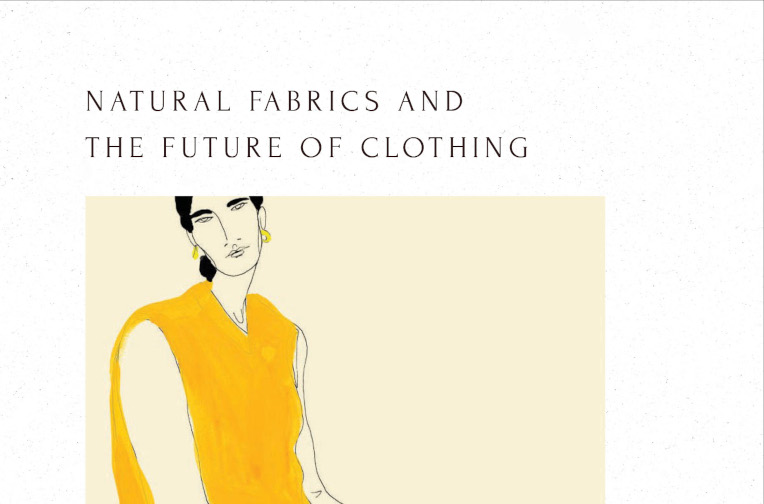From Sundressed: Natural Fabrics and the Future of Clothing by Lucianne Tonti. Copyright ©2023 by Lucianne Tonti. Reproduced by permission of Island Press, Washington, D.C.

Sundressed: Natural Fabrics and the Future of Clothing
By: Lucianne Tonti
Chapter 4. La Dolce Vita and the Australian Merino
Pg. 69-71
Since further back in time than we can comprehend, more than five hundred different clan groups or nations cared for the continent of Australia. They passed down knowledge of the soil, vegetation, water stores, and landforms and, over eons, developed a deep understanding of Australia’s long-term climate cycles and ecosystems. They used intricate cultural practices, spiritual networks, and unique social structures to tend to the land; their rituals were born of The Dreaming (an inadequate English translation) – a religion grounded in the land itself. They lived as part of the natural world; their ancestors had shaped the land, its rivers, mountains, forests, and deserts before returning to it and so the land owned them, raised them, and, in turn, their responsibility was to care for it. Time was circular, and the law prescribed the world be left as it was found.
Europeans invaded Australia in 1788, bringing with them the dominate-and-destroy mantra of the Industrial Revolution. In his book, Dark Emu, Indigenous author Bruce Pascoe says the early colonizers described a landscape of rolling grasslands and fertile pastures, kangaroo grass that was so high it concealed the flocks of the first settlers and fields so lush that orchids, lilies, and mosses grew among the grain crops. The colonizers did not recognize that Australia was farmed and harvested, perhaps because the narrative that the land was not cultivated suited their claims of sovereignty, or perhaps because the approach of the Indigenous people was so foreign to the ordered fields of Europe. They quickly imported European agricultural principles, which had a terrible effect on the country’s carefully managed ecology, and embarked on unprecedented land clearing, decimating forests of native trees and rendering vast swathes of the country unrecognizable. The scope of the tragedy they inflicted is difficult to comprehend. Alongside the devastation of the landscape, a violent war was waged on the Indigenous people and, within 140 years, Australia’s Indigenous population had collapsed to less than ten percent of 1788 levels. According to Massy, the Europeans had failed to fully appreciate “that the land and its Indigenous people were so inextricably bound, that the destruction of one inevitably entailed the destruction of the other.”
The sheep that arrived with the first ships ate the verdant pastures of Indigenous Australia right to the ground, destroying the landscape’s fertility in just a few seasons. This narrative runs in stark contrast to white Australia’s history, which celebrates the pastoral endeavors of pioneers and that the Australian economy “rode on the sheep’s back.” And for a while it did: through genetic development of the Merino sheep and superfine fibers that are sought after by fashion designers all over the world, Australia became the world’s primary producer of apparel wool, a sector with a retail expenditure of $80 billion per year. The industry created wealth and power for the dispossessors, and the landscape was destroyed by farmers and companies that did not understand the ecology of the place they had stolen.
When I ask Massy if it’s really okay to be farming sheep in a country so vulnerable to climate change, given how quickly European agriculture destroyed Australia’s native grasses, he replies, “Look, I see in books by learned professors that hooved animals are the worst thing to ever come into the Australian environment because it can be more delicate than other continents – which it is, in some respects. But the message from the overgrazing story is that it wasn’t their hooves, it was their mouths; it’s the eating out of grasses that leads to compaction from hooves.”
He emphasizes that regenerative grazing practices can be hugely beneficial – how, along with animal dung and urine, hooves can be constructive tools. He points out that through these systems, a fiber like wool is coming from an animal that is helping regenerate the earth.
The idea that regenerative grazing systems have the capacity to restore carbon to the soil has been proven by Rebecca Burgess in California. Fibershed’s Climate Beneficial Wool Program measures soil carbon storage so that wool coming from regenerative grazing landscapes can be verified as climate-beneficial. Her work and studies have shown that if a garment has been made from wool that was grown on a regeneratively grazed sheep and processed in a supply chain powered by renewable energy, the end garment will have a negative CO2 footprint. One of the studies was from UC Berkeley’s Silver Lab and conducted by Dr. Marcia DeLonge, who found that applying compost to rangelands where sheep grazed produced wool with a net carbon benefit.
The excitement in Massy’s voice is palpable when he tells me that recently he was looking out across his farm with a botany enthusiast who told him that before whites arrived in 1820, the whole landscape would have been orange. And now, thanks to holistic grazing, swathes of orange kangaroo grass are emerging across his land.





